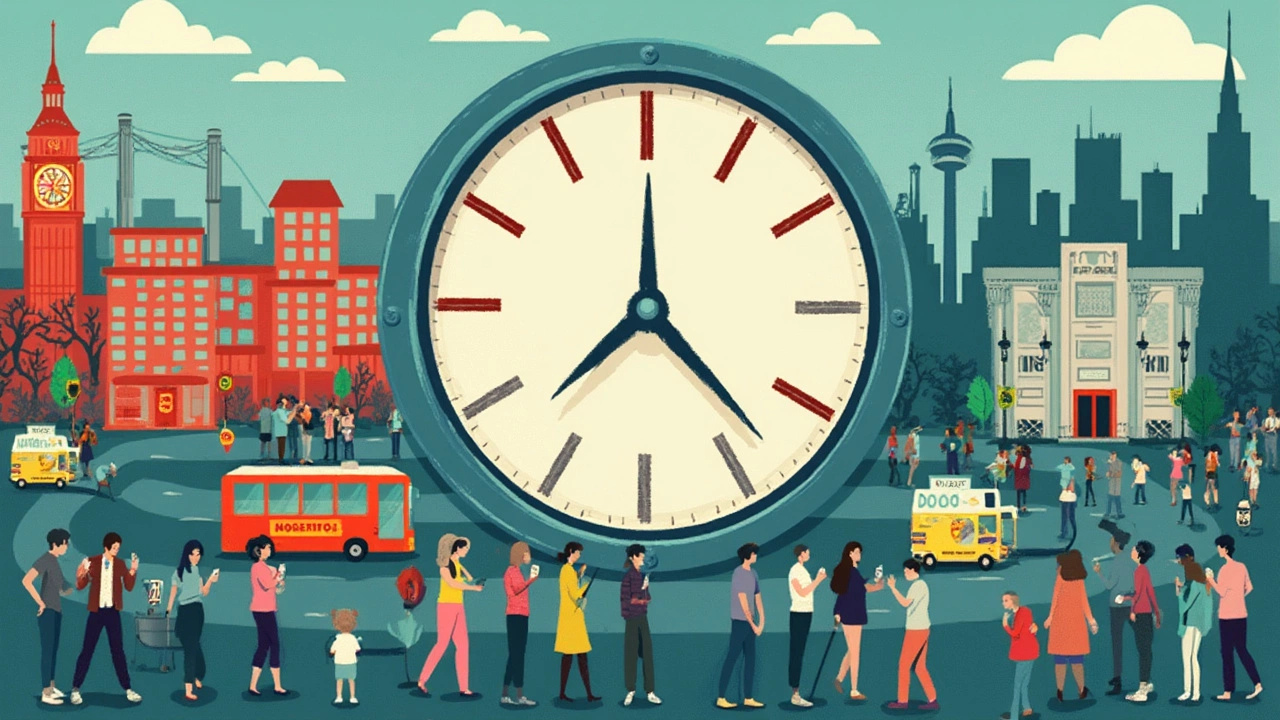 Jun, 17 2025
Jun, 17 2025
If you’ve ever waited weeks for a doctor’s appointment, you know how much timing matters. NHS waiting times might feel like the standard punchline, but try calling some US specialist offices—people there can still run into month-long waits, even with insurance. The difference isn’t always as simple as 'public vs private.' It really depends on what kind of care you need.
For most people in England, routine NHS appointments—like seeing your GP—are supposed to happen within two weeks. But if you’re being referred to a specialist, waits of 3-6 months aren’t unusual, especially after the pandemic. Worse, more than 50% of people in 2025 needing non-urgent consultant-led treatment have waited over 18 weeks, according to NHS England data. Big city hospitals might see you quicker, but small towns often make you wait much longer.
- How NHS Wait Times Stack Up
- What Patients Experience in the US
- Why Waiting Happens: The Main Factors
- Tips to Beat the Queue
How NHS Wait Times Stack Up
When it comes to getting seen in the UK, NHS waiting times can feel painfully long, especially if you’re not sure how the system works. For everyday stuff—like a cough or routine checkup—seeing your GP is usually quick. The NHS aims to give you a GP appointment within two weeks, but lots of folks say they end up waiting longer, especially after COVID hit. If you want to see a specialist, the clock really starts to tick.
NHS England tries to get everyone who needs non-urgent consultant-led treatment seen within 18 weeks from referral. The reality? That target was missed big time in 2024 and rolled right into 2025. Right now, less than half of patients actually get seen within those 18 weeks. The hardest-hit areas are things like hip replacements, cataract surgery, and dermatology.
Here’s what the real wait time picture looks like for different types of treatment in England (2025):
| Type of Care | Average Wait Time | NHS Target |
|---|---|---|
| GP Appointment | 8 days | 2 weeks or sooner |
| Non-Urgent Consultant Treatment | 21 weeks | 18 weeks |
| Planned Surgery (hips, knees, etc.) | 28 weeks | 18 weeks |
| Cancer Referral (Urgent) | 14 days | 2 weeks |
Emergency care is handled faster. If you rock up to A&E (the British equivalent of the ER), the standard is to be seen, treated, or admitted within 4 hours. But only about 68% of people were actually seen in that time in early 2025—way below the 95% target.
If you live in a rural area or a smaller city, waiting can be even worse. Some patients in small towns reported waits for operations stretching past a year. That's why terms like "NHS waiting list" show up everywhere in British headlines. In June 2025, over 7.7 million people in England were on those lists—more than 1 out of every 8 people.
If you're stuck waiting, there are a couple of things you can do: ask your GP about cancellations, try different hospitals, or even see if you qualify for an urgent referral. But for non-urgent stuff, expect the process to move at snail's pace.
Bottom line: NHS wait times are at record highs for non-emergencies, and the numbers haven't improved much so far in 2025. If you can, try to be flexible, and always ask if there’s a waiting list alternative.
What Patients Experience in the US
People think the US healthcare system is all about speed and convenience—but that’s not always the case. Sure, if you show up to an emergency room with something serious, you’ll get seen fast. But for regular stuff, like checkups or non-urgent specialist visits, the wait can be a lot longer than you’d expect. The way your insurance works, where you live, and which doctors are available all shape your experience.
If you need a routine appointment, the average wait time in the US is actually creeping up. In 2024, a Merritt Hawkins survey found people wait an average of 26 days to see a new family medicine doctor in big cities. Need a dermatologist or neurologist? Some patients reported waits past 60 days. It’s not just about booking the visit—insurance pre-approvals and paperwork can stretch things out even further.
| Specialty | US Average Wait (2024) |
|---|---|
| Family Medicine | 26 days |
| Dermatology | 34 days |
| Orthopedics | 16 days |
| Cardiology | 21 days |
| Neurology | 61 days |
Where things get really complicated is cost. In the US, even if you get a quick appointment, you might hesitate because of high out-of-pocket fees, especially if you’re on a high-deductible plan. About 30% of American adults have skipped needed care just to avoid these surprise bills. That’s a big difference from the NHS, where care is 'free at the point of use.'
That said, urgent and emergency care moves faster than routine care in both the US and UK. But if you’re trying to get in for a scheduled surgery or specialist consult, the so-called speed of the US system can suddenly feel sluggish—especially if your insurance network is limited. Finding an in-network specialist sometimes means more calls and more time on hold than you bargained for.
- If you have a rare or complex condition, chances are you'll wait less in a major US city—if you’re insured and can afford it.
- For regular primary care, wait times aren’t all that different from the NHS in many places.
- Poorer areas and rural communities see far longer waits, because doctors are booked out months in advance or just aren’t available.
Bottom line: the NHS wait times get a lot of attention, but the reality is the US isn’t always speedy, either. What really matters is what you’re waiting for, and how easy it is to pay once you finally get that call.

Why Waiting Happens: The Main Factors
If you’ve spent hours in a waiting room or weeks checking for appointment updates, you’ve probably wondered what really causes the hold-ups. It isn’t just one thing—it’s a handful of issues stacking up on both sides of the Atlantic.
In the NHS, the biggest headache is the shortage of doctors and staff. Right now, England is short about 10,000 doctors, and nursing shortages are even worse. Add to that an aging population and a backlog from the COVID-19 pandemic, and you get the long NHS wait times everyone talks about. Money matters too. Public funding hasn’t kept up with demand, which means crowded hospitals and fewer available appointments.
On the US side, the story’s a bit different. Yes, insurance rules play a big part—if you don’t have the right plan, you’ll wait for approvals or sometimes pay out of pocket to get seen fast. There are also “prior authorizations,” meaning you are stuck until your insurance greenlights treatment. And sure, big city hospitals in the US have more doctors, but some states—like Mississippi or Wyoming—have severe shortages, so you could end up waiting just as long as in the UK.
- Staff shortfalls slow down care everywhere, but especially in rural or underfunded areas.
- More patients with chronic illnesses (think diabetes or heart disease) mean clinics fill up faster.
- Outdated hospital buildings and equipment can drag out treatment times.
- Insurance paperwork in the US adds extra delays you might not expect.
Want to see how the backlog really looks? Check out the numbers below:
| Issue | NHS (UK) | US Healthcare |
|---|---|---|
| Average GP Wait (non-urgent) | 2-3 weeks | 1-2 weeks |
| Specialist Wait (non-urgent) | 3-6 months | 1-4 weeks (private), up to 2+ months (some areas) |
| Staff Shortage | ~10,000 doctors short (2025), 43,000 nurses short | Worse in rural areas, 83% of rural US is medically underserved (2024) |
| Insurance Barriers | Not a main concern | Major factor—prior authorizations and network limits |
The bottom line: it’s usually a mix of not enough staff, old resources, lots of patients, and (in the US) insurance hoops that keep people waiting. The problems aren’t going away soon, but being aware lets you plan better.
Tips to Beat the Queue
Getting stuck behind a mountain of other patients isn’t fun, but there are some ways you can trim down NHS wait times or speed up things in the US. You just need to know which levers to pull—and which doors to knock on.
- Talk to Your GP or Primary Doctor: In the NHS, your GP controls the keys to referrals. Ask them if you can be sent to alternative hospitals or clinics with shorter lists. Some lesser-known places have much quicker turnaround. In the US, your regular doctor might nudge your request as ‘urgent’ if your symptoms change, moving you up the list.
- Check Multiple Providers: In the US, most insurers list many in-network options. Sometimes, a surgeon one town over has a sooner slot. In the NHS, you’re entitled to choose where you get treated under the NHS Choice Framework. A simple call or booking online could drop weeks off your wait.
- Ask for Cancellations: Always let staff know you’re happy to take a last-minute slot. Many places keep a list of patients who can show up on short notice. It’s not the official system, but it works. In some specialty clinics, nearly 10% of bookings are cancellations—they get filled fast.
- Go Private (If You Can Swing It): If the wait for your NHS procedure is dragging on and you can afford it, some people pay privately for just the consultation, then jump back into the NHS queue with a specialist letter. Not everyone’s cup of tea, but it does work for speeding things up.
- For Immediate Care, Use Urgent Clinics or Telemedicine: Instead of waiting for a standard slot, walk-in centres and urgent care clinics (NHS Urgent Treatment Centres or US urgent care) can sort common issues fast. Telemedicine is also a smart move, with average video consults in the US now available in under 7 minutes according to data from 2024.
To give you an idea of just how much these steps can affect your wait, here’s a quick comparison of typical waiting time reductions based on different actions:
| Action | Average Time Saved (NHS) | Average Time Saved (US) |
|---|---|---|
| Switching to a hospital with shorter list | Up to 6 weeks | Up to 2 weeks |
| Getting on a cancellation list | 2–4 weeks | 1–3 weeks |
| Using telemedicine/urgent care | 1–2 days | Same day |
| Going private for consult then back to public | Up to 8 weeks | N/A |
It’s not about cutting in line, but knowing the shortcuts that nobody tells you. Sometimes just asking a few extra questions or clicking the right online form is enough to save weeks on your journey to getting sorted.
